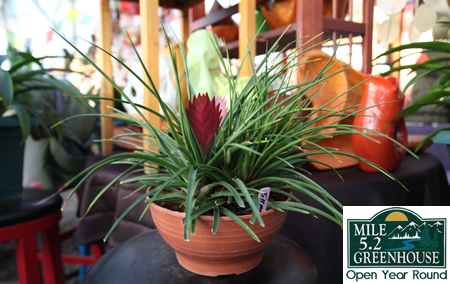Tillandsia Cyanea
Also known as the “Pink Quill” plant, the Tillandsia Cyanea are excellent plants for Alaskan homes and offices due to their preference for low light levels.

All Bromeliads bloom once in their lifetime and then they die, however they will reproduce by creating new plants, referred to as pups.
A Pink Quill plant begins the whole flowering process by developing a bright pink paddle, or bract. This bract will produce little purple flowers, each little groove along the bract will produce one purple flower sometimes more than one groove will flower at a time. Each purple flower will only last a short time as others will come from other grooves. Once all of the grooves have produced a flower, the bract will die off, this usually takes weeks after which the entire plant will die off, however this could take several months. When the bract becomes unattractive you can simply cut it off at the base. This will have completed the flowering process.
Most often, pups (baby off-shoots) will develop during or after the flowering cycle emerging at the outer base of the plant. The original plant, especially if helped along with a very small amount of diluted fertilizer, may continue to produce pups until it has completely expired. The pups will grow on and eventually produce their own bracts.
Many factors cause bromeliads to bloom such as plant age, day length, light intensity, water and temperature. Some bromeliads bloom quite regularly while others do not. It is known that the bromeliad flowering process can be induced by exposing the plant to ethylene gas (a product of burning wood and leaves and ripening fruit and vegetables). A simple method that can be done at home to stimulate flowering is to place a healthy, mature plant (at least ½ the size that the mother was) with all the water drained, in a tightly closed, bag (paper or plastic) for a 24 to 48 hours with a ripe to overripe apple or banana. During senescence (the aging process), the fruit releases ethylene gas that, in turn, induces the bromeliad to flower.
The Bromeliad reproduction process is slow, which is also why they are known to be long lasting, so be patient.


